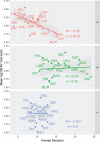Associations of functional human leucocyte antigen class I groups with HIV viral load in a heterogeneous cohort
- PMID: 37534724
- PMCID: PMC10399941
- DOI: 10.1097/QAD.0000000000003557
Associations of functional human leucocyte antigen class I groups with HIV viral load in a heterogeneous cohort
Abstract
Objective: Human leucocyte antigen (HLA) class I alleles are the main host genetic factors involved in controlling HIV-1 viral load (VL). Nevertheless, HLA diversity has proven a significant challenge in association studies. We assessed how accounting for binding affinities of HLA class I alleles to HIV-1 peptides facilitate association testing of HLA with HIV-1 VL in a heterogeneous cohort.
Design: Cohort from the Strategic Timing of AntiRetroviral Treatment (START) study.
Methods: We imputed HLA class I alleles from host genetic data (2546 HIV+ participants) and sampled immunopeptidomes from 2079 host-paired viral genomes (targeted amplicon sequencing). We predicted HLA class I binding affinities to HIV-1 and unspecific peptides, grouping alleles into functional clusters through consensus clustering. These functional HLA class I clusters were used to test associations with HIV VL.
Results: We identified four clades totaling 30 HLA alleles accounting for 11.4% variability in VL. We highlight HLA-B∗57:01 and B∗57:03 as functionally similar but yet overrepresented in distinct ethnic groups, showing when combined a protective association with HIV+ VL (log, β -0.25; adj. P-value < 0.05). We further demonstrate only a slight power reduction when using unspecific immunopeptidomes, facilitating the use of the inferred functional HLA groups in other studies.
Conclusion: The outlined computational approach provides a robust and efficient way to incorporate HLA function and peptide diversity, aiding clinical association studies in heterogeneous cohorts. To facilitate access to the proposed methods and results we provide an interactive application for exploring data.
Copyright © 2023 The Author(s). Published by Wolters Kluwer Health, Inc.
Conflict of interest statement
There are no conflicts of interest.
Figures
Comment in
-
A new look at human leukocyte antigen variation in HIV; functional clustering to enhance power for discovery of host genetic associations.AIDS. 2023 Sep 1;37(11):1757-1758. doi: 10.1097/QAD.0000000000003636. Epub 2023 Jun 28. AIDS. 2023. PMID: 37534725 No abstract available.
References
-
- Ekenberg C, Tang MH, Zucco AG, Murray DD, MacPherson CR, Hu X, et al. . Association between single-nucleotide polymorphisms in HLA alleles and human immunodeficiency virus type 1 viral load in demographically diverse, antiretroviral therapy–naive participants from the Strategic Timing of AntiRetroviral Treatment Trial. J Infect Dis 2019; 220:1325–1334. - PMC - PubMed
Publication types
MeSH terms
Substances
Grants and funding
LinkOut - more resources
Full Text Sources
Medical
Research Materials




